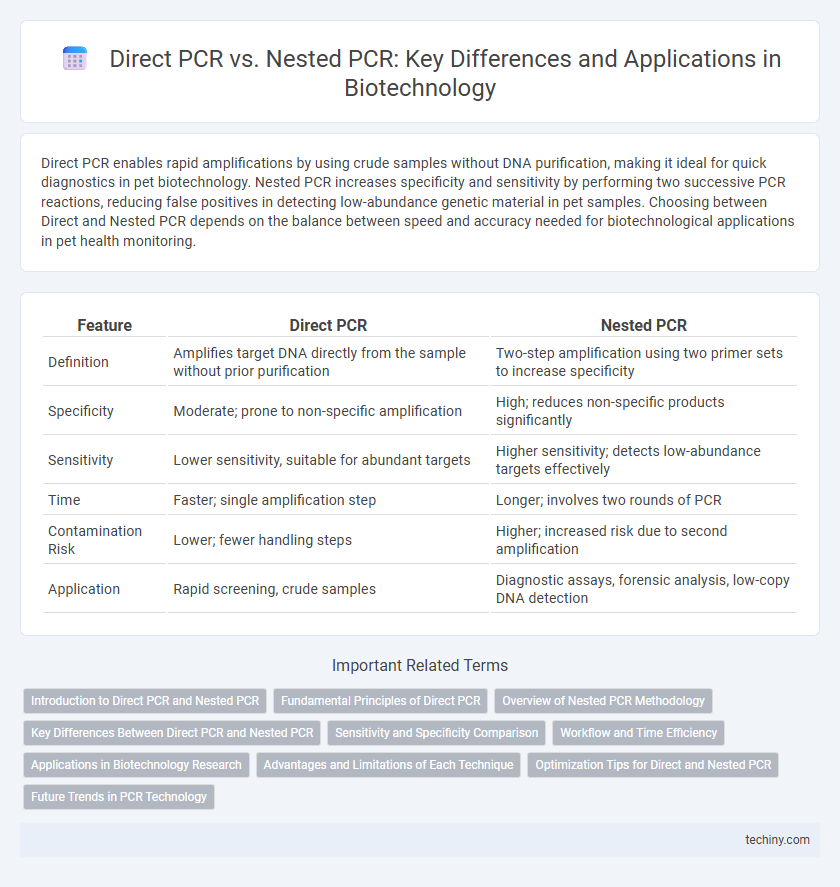Direct PCR enables rapid amplifications by using crude samples without DNA purification, making it ideal for quick diagnostics in pet biotechnology. Nested PCR increases specificity and sensitivity by performing two successive PCR reactions, reducing false positives in detecting low-abundance genetic material in pet samples. Choosing between Direct and Nested PCR depends on the balance between speed and accuracy needed for biotechnological applications in pet health monitoring.
Table of Comparison
| Feature | Direct PCR | Nested PCR |
|---|---|---|
| Definition | Amplifies target DNA directly from the sample without prior purification | Two-step amplification using two primer sets to increase specificity |
| Specificity | Moderate; prone to non-specific amplification | High; reduces non-specific products significantly |
| Sensitivity | Lower sensitivity, suitable for abundant targets | Higher sensitivity; detects low-abundance targets effectively |
| Time | Faster; single amplification step | Longer; involves two rounds of PCR |
| Contamination Risk | Lower; fewer handling steps | Higher; increased risk due to second amplification |
| Application | Rapid screening, crude samples | Diagnostic assays, forensic analysis, low-copy DNA detection |
Introduction to Direct PCR and Nested PCR
Direct PCR enables the amplification of DNA sequences directly from biological samples without prior DNA purification, significantly reducing processing time and minimizing contamination risks. Nested PCR involves two successive rounds of amplification using two sets of primers to increase sensitivity and specificity, particularly useful for detecting low-abundance targets in complex samples. Both techniques serve distinct roles in molecular diagnostics and genetic research, with Direct PCR favored for rapid screening and Nested PCR for precise identification of target sequences.
Fundamental Principles of Direct PCR
Direct PCR amplifies target DNA sequences directly from biological samples without prior DNA purification, streamlining the workflow and reducing contamination risk. This method utilizes robust polymerases capable of tolerating inhibitors present in complex matrices, enabling rapid and efficient amplification. Ideal applications include diagnostics and genotyping where speed and simplicity are critical for effective molecular analysis.
Overview of Nested PCR Methodology
Nested PCR methodology involves two successive rounds of polymerase chain reaction to enhance DNA amplification specificity and sensitivity. The first PCR uses outer primers to amplify a broad target region, followed by a second PCR employing inner primers nested within the initial product to reduce non-specific amplification and background noise. This technique is invaluable for detecting low-abundance nucleic acid sequences in complex biological samples, providing superior accuracy compared to direct PCR.
Key Differences Between Direct PCR and Nested PCR
Direct PCR amplifies target DNA directly from crude samples without prior DNA purification, enabling rapid and cost-effective analysis but with increased risk of non-specific amplification. Nested PCR involves two successive rounds of amplification using two sets of primers to enhance specificity and sensitivity, reducing false positives in complex samples. The key difference lies in Nested PCR's superior precision and lower contamination risk versus Direct PCR's speed and simplicity.
Sensitivity and Specificity Comparison
Direct PCR offers rapid amplification with moderate sensitivity but can be limited by inhibitors present in samples, reducing specificity. Nested PCR enhances sensitivity significantly by using two sets of primers in successive rounds, resulting in higher specificity and reduced non-specific amplification. The trade-off is that nested PCR is more time-consuming and prone to contamination, but it provides superior detection of low-abundance targets compared to direct PCR.
Workflow and Time Efficiency
Direct PCR streamlines the workflow by amplifying target DNA directly from the sample without the need for prior DNA extraction, significantly reducing preparation time and complexity. Nested PCR involves two successive amplification steps, increasing specificity and sensitivity but doubling the processing time and labor. Laboratories prioritize Direct PCR for rapid diagnostics, while Nested PCR is chosen when accuracy outweighs time efficiency.
Applications in Biotechnology Research
Direct PCR enables rapid amplification of target DNA from crude samples without prior purification, accelerating microbial detection and environmental monitoring in biotechnology. Nested PCR enhances sensitivity and specificity by using two successive primer sets, making it ideal for detecting low-abundance genetic variants or rare mutations in gene expression studies and clinical diagnostics. Both techniques facilitate accurate genetic analysis, supporting developments in drug discovery, genetic engineering, and synthetic biology.
Advantages and Limitations of Each Technique
Direct PCR offers a streamlined approach by allowing amplification directly from biological samples without DNA purification, saving time and reducing contamination risk, but it may suffer from lower sensitivity and specificity due to inhibitors in the sample. Nested PCR enhances sensitivity and specificity through two successive rounds of amplification targeting a specific DNA region, making it ideal for detecting low-abundance or degraded DNA, but it requires more time, reagents, and increases contamination risk. While Direct PCR is advantageous for rapid screening, Nested PCR's precision makes it superior for applications demanding high accuracy in pathogen detection or genetic analysis.
Optimization Tips for Direct and Nested PCR
Optimize Direct PCR by selecting robust polymerases resistant to inhibitors found in crude samples and fine-tuning annealing temperatures to enhance primer specificity. For Nested PCR, design inner and outer primers with distinct melting temperatures and incorporate stringent cycling conditions to minimize non-specific amplification. Employing appropriate template purification and reaction additives such as betaine or DMSO can further improve amplification efficiency in both techniques.
Future Trends in PCR Technology
Future trends in PCR technology emphasize enhanced sensitivity and speed through innovations like digital PCR and microfluidic platforms, which improve direct PCR efficiency by minimizing sample preparation. Nested PCR continues to benefit from automation and multiplexing capabilities, reducing contamination risk and increasing specificity in complex genetic analyses. Emerging technologies integrate AI-driven data analysis to streamline results interpretation, pushing the boundaries of PCR accuracy and scalability in biotechnology research.
Direct PCR vs Nested PCR Infographic

 techiny.com
techiny.com